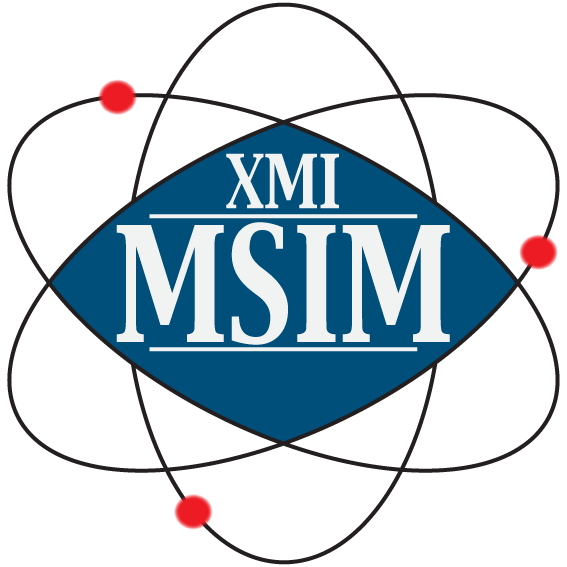Software
XDS
X-ray Detector Software for processing single-crystal monochromatic diffraction data recorded by the rotation method. It processes a sequence of adjacent, nonoverlapping rotation images collected from a single-crystal at a fixed X-ray wavelength and recorded by a variety of imaging plate, CCD, pixel and multiwire area detectors; allows arbitrary but fixed orientations of the detector and rotation axis, and only requires that incident beam and rotation axis intercept in one point in the center of the crystal; automatically derives reflecting range, spot width, crystal orientation, symmetry, and cell parameters from the data images. delivers a list of corrected integrated intensities of the reflections occuring in the data images.
XDSAPP
XDSAPP is a graphical user interface for the processing of diffraction data sets using XDS. It automates the data hadling and generates graphical plots of various data set statistics provided by XDS and other programs. By incorporating additional software, further information on certain features of the data set, such as radiation decay or the presence of pseudo-translational symmetry and/or twinning is provided. Intensity files suitable for CCP4, SHELX and CNS are automatically generated.

XMI-MSIM
XMI-MSIM is an open source tool designed for predicting the spectral response of energy-dispersive X-ray fluorescence spectrometers using Monte Carlo simulations. It comes with a fully functional graphical user interface in order to make it as user friendly as possible. Considerable effort has been taken to ensure easy installation on all major platforms. A manuscript has been published in Spectrochimica Acta Part B that covers the algorithms that power XMI-MSIM. Please include a reference to this publication in your own work if you decide to use XMI-MSIM for academic purposes. A second manuscript was published that covers our XMI-MSIM based quantification plug-in for PyMca. XMI-MSIM is released under the terms of the GPLv3.

XOP (includes SHADOWVUI)
XOP (X-ray Oriented Programs) is a widget-based driver program used as a common front-end interface for modelling of x-ray sources characteristics of optical devices (mirror, filters, crystals, multilayers, etc.); multipurpose data visualizations and analyses
xraylib
Quantitative estimate of elemental composition by spectroscopic and imaging techniques using X-ray fluorescence requires the availability of accurate data of X-ray interaction with matter. Although a wide number of computer codes and data sets are reported in literature, none of them is presented in the form of freely available library functions which can be easily included in software applications for X-ray fluorescence. This work presents a compilation of data sets from different published works and an xraylib interface in the form of callable functions. Although the target applications are on X-ray fluorescence, cross sections of interactions like photoionization, coherent scattering and Compton scattering, as well as form factors and anomalous scattering functions, are also available. xraylib provides access to some of the most respected databases of physical data in the field of X-rays. The core of xraylib is a library, written in ANSI C, containing over 40 functions to be used to retrieve data from these databases. This C library can be directly linked with any program written in C, C++ or Objective-C. Furthermore, the xraylib package contains bindings to several popular programming languages: Fortran 2003, Perl, Python, Java, IDL, Lua, Ruby, PHP and .NET, as well as a command-line utility which can be used as a pocket-calculator. Although not officially supported, xraylib has been reported to be useable from within Matlab and LabView. The source code is known to compile and run on the following platforms: Linux, Mac OS X, Solaris, FreeBSD and Windows. It is very likely that xraylib will also work on other platforms: we would be grateful if you would report your successes in this regard. Please note that not all of the bindings are currently working on all platforms. A paper was published concerning xraylib by A. Brunetti, M. Sanchez del Rio, B. Golosio, A. Simionovici and A. Somogyi, “A library for X-ray matter interaction cross sections for X-ray fluorescence applications”, Spectrochimica Acta B 59 (2004) 1725-1731. This paper was recently superseded by a new manuscript, covering all features of xraylib upto version 2.15.0, written by T. Schoonjans, A. Brunetti, B. Golosio, M. Sanchez del Rio, V. A. Solé, C. Ferrero and L. Vincze, named "The xraylib library for X-ray—matter interactions. Recent developments". You are kindly requested to include this paper in the reference list of your published work when you would decide to use xraylib for scientific purposes.
XRDUA
software package developed by the Antwerp X-ray Imaging/Instrumentation Laboratory (AXiL) at the University of Antwerp. Its main purpose is to automate the processing of two dimensional x-ray diffraction images from scanning micro-XRPD or micro-XRPD tomography. It accepts images from flat area detectors and allows correction, calibration and modeling (Rietveld, Pawley, Pattern Decomposition). The primary goal is to visualize crystalline phase distributions in projection (2D scanning) or in a virtual cross section (tomography) of the object under investigation. Apart from the amount of material, structural properties and their changes within the object can be calculated and visualized as well.
XRMC
XRMC is a Monte Carlo program for accurate simulation of X-ray imaging and spectroscopy experiments in heterogeneous samples. The use of the Monte Carlo method makes the code suitable for the detailed simulation of complex experiments on generic samples. Variance reduction techniques are used for reducing considerably the computation time compared to general purpose Monte Carlo programs. The program is written in C++ and has been tested on Linux, Mac OS X and MS Windows platforms. XRMC is released under the terms of the GPLv3.

